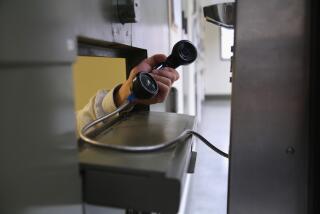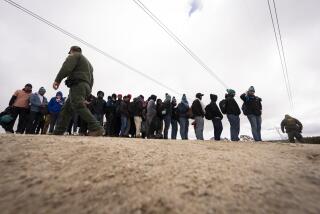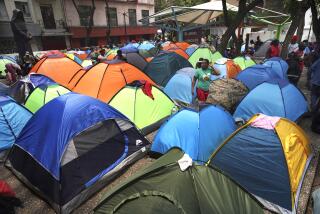To This Illegal Alien It’s a New Kind of ‘Freedom Fight’
NEW YORK — When fireworks light up the sky next week to celebrate the 100-year-old Statue of Liberty and her cherished welcome to immigrants, Ghalam Mohammad Paiman will hear the party. But he won’t be cheering.
“The Statue of Liberty represents freedom and justice to many millions,” the 22-year-old Afghan said Wednesday in a cinder-block room with barred windows barely a mile from the statue’s golden torch. “But I am confined in this prison. I feel not free. And that is not just.”
Paiman is a former mojahedeen, a U.S.-backed “freedom fighter” who took arms for three years against the Soviet Army in Afghanistan. According to court papers, Paiman was tortured with hot coals in prison in Kabul, his two brothers are in jail for anti-Soviet activities and he would be “eliminated” if he returned home.
Asylum Denied
But Paiman arrived at John F. Kennedy International Airport in New York last Jan. 12 without a passport or visa. He has been incarcerated ever since with 169 other illegal aliens in an Immigration and Naturalization Service detention center in Lower Manhattan. His application for political asylum was denied. He remains imprisoned while he fights deportation to a third country.
“When I came to this country, I had high expectations of liberty and peace,” said Paiman, speaking in Farsi through an interpreter. “I expected to be treated with dignity. I expected human rights to be honored. I am not a criminal. But I am treated like a criminal.”
Paiman’s plight, and that of many of the 5,000 stateless persons incarcerated in eight INS detention centers across the country is drawing special attention as the long-heralded Liberty Weekend approaches.
The immigration service has always used detention facilities, including Ellis Island, to screen and deport aliens. But until 1980, most applicants for asylum were released on bond or parole while they fought for legal status here.
Changed With Cubans
That changed with the onslaught of hundreds of thousands of Cubans and Haitians who arrived in 1980-81. Since then, increasing numbers of applicants for political asylum and other refugees from countries like Afghanistan, Ethiopia, El Salvador, Guatamala and Iran have been incarcerated while they seek haven in the United States. The average detention is two to three weeks, but some have been imprisoned three years and longer.
In a report to be released today, the Lawyers Committee for Human Rights and Helsinki Watch groups, two nonprofit human rights advocacy organizations, charge that current immigration detention policies “violate domestic and international law.”
“This is an invention of the Reagan Administration,” said Arthur C. Helton, director of the political asylum project for the Lawyers Committee for Human Rights in New York. “It illustrates how our rhetoric of compassion has broken down in practice. It provides a cruel contrast to the rededication of the Statue of Liberty.”
Immigration officials say the detention facilities discourage aliens who try to circumvent legal immigration and asylum procedures. “Detention acts as a deterrent,” said Scott Blackman, assistant INS district director for detention and deportation in New York.
75% Jump Bond
As it is, said Maurice C. Inman Jr., general counsel for the INS in Washington, the immigration system is overloaded with 1.4 million illegal aliens and some 140,000 court cases a year. Three out of four aspiring immigrants jump bond, he said.
“These people by rights should be in jail,” Inman said. “They are here illegally . . . . There are 15 million people trying to enter the U.S. legally. These people are gate-crashers, line-jumpers. They are not worthy of much sympathy.”
“All of those persons who have been detained will lose their asylum cases,” Inman added. “All of them. Otherwise they would not be detained.”
The immigration prisons are in Boston, New York, Miami, Houston and border areas in Texas, Arizona and California. The newest and largest immigration detention center, with more than 1,000 beds, opened in March in Oakdale, in central Louisiana.
Another 1,869 Cuban criminals who arrived in the 1980 Mariel boat lift are at the Atlanta Federal Penitentiary, in conditions “worse than those which exist for the most dangerous convicted felons,” said an April report by the House Judiciary subcommittee on courts and civil liberties.
Proof of Persecution
Under law, refugees are granted asylum if they can demonstrate a well-founded fear of persecution in their own country because of race, religion, nationality or membership in a particular social group, or political opinion.
The law does not provide asylum to those who are not individual targets of persecution, but who suffer from general war, civil unrest or economic crisis. Nor does the law provide asylum simply because refugees come from communist regimes or dictatorships.
Despite the detentions, the United States remains the world’s most open-armed nation. Last year, it issued immigrant visas to 567,000 people and admitted some 70,000 refugees, including 59,000 from the Soviet Union, Eastern Europe and Indochina.
“Probably 1% of the asylum claimants are detained,” Inman said. “Overall, our country takes more refugees and asylees, more than twice as many as the rest of the world combined. And the Reagan Administration has taken in more asylees than any other administration since World War II.”
Recalled Schoolbooks
But others say the detentions close a harsh door in the face of some, like Paiman, who saw pictures of the statue’s beacon in schoolbooks far away.
“The Statue of Liberty represents liberty for people,” said Michael Myers, Washington representative for Church World Service, a division of the National Council of Churches. “For the most part, that has been available. Here is one population for whom the proclamation of the Lady of the Harbor needs to be heard a bit more loudly.”
More to Read
Sign up for Essential California
The most important California stories and recommendations in your inbox every morning.
You may occasionally receive promotional content from the Los Angeles Times.











